Pawleys Island turtle season on track for another successful nesting year
With 20 nests so far, officials credit a caring public for another successful turtle nesting season on Pawleys Island.
The success stems, in part, because there has been less “false crawls” by mother sea turtles than usual.
From mid-May to mid-October, known as turtle season, female sea turtles crawl up the beach to the dunes at night to lay their eggs, burying them in the sand. A “false crawl” signifies a failed attempt by the mother to lay eggs, and officials have found less of these this year, which may account for the high number of nests so far this year.
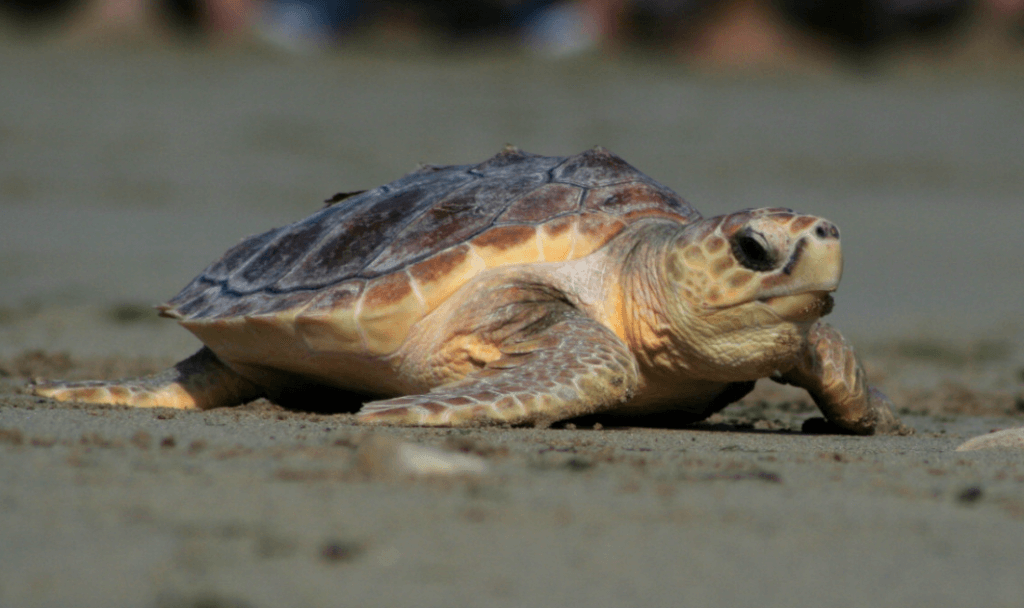
Volunteers with South Carolina United Turtle Enthusiasts, or SCUTE for short, walk the Pawleys Island beach every morning in search of turtle tracks.
Each season, SCUTE leaders ask the public to be aware of this special time of year and do their part to help the sea turtles, and it seams to be paying off. Rick Scott, head of SCUTE, which spans beaches from Myrtle Beach to the north and Georgetown to the south, said the public has been very helpful this year, as well as the weather.
“We are having fewer false crawls, implying that renters of the beachfront houses, condos and hotels are doing a good job managing their lights, noise, etc.,” Scott said. “And currently we have no major storms threatening our nests. Hopefully that will remain the case in coming weeks.”
Walking the beach
“All of our volunteers look forward to ‘turtle season,’” said Mary Schneider, SCUTE coordinator for Pawleys Island. “They walk early in the morning when it is quiet and peaceful on the beach, and they get to see some beautiful sunrises.”
Every second or third year, female turtles lay four or five nests a season, each containing an average of 120 ping-pong-sized eggs. Nests that are laid in the inter-tidal zone or areas at risk for foot traffic are carefully relocated by SCUTE volunteers who have been trained and authorized by the South Carolina Department of Natural Resources. You can spot SCUTE-tagged sea turtle nests by their distinctive orange screening and orange signs on nest poles.
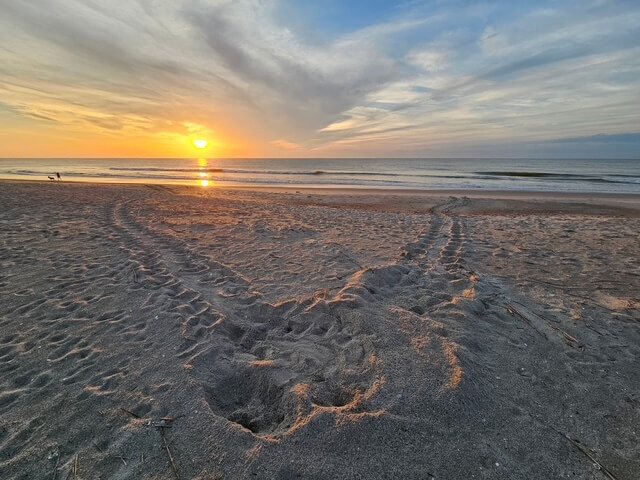
Schneider, who has served as a SCUTE coordinator for Pawleys Island for more than 20 years, said that the number of nests on the island mesh with previous years.
“We have 20 nests on Pawleys which is good for us this year,” she said. “The total nests in the state is lower than normal, but 20 has been our number the last couple of years.”
Scott agreed that Pawleys Island is on track according to the number of nests seen this season.
Other SCUTE locations on the South Carolina’s Hammock Coast include Debordieu, which has 25 nests so far; Hobcaw/Prince George, which has 24; South Litchfield, which has six; Lichfield By The Sea, which has four; North Litchfield, which has three; and Huntington Beach State Park, which has only four nests after a record 33 nest in 2024. Garden City, which is located in both Georgetown and Horry counties, and Surfside Beach in Horry County have seen nine nests each, he said.
“Since loggerhead turtles nest every two to three years, the turtles we are seeing this year last laid here in 2022 or 2023,” Scott said.
Concerns for the future
Schneider and Scott say that eggs in turtle nests have been hatching at a faster rate than other years on record. They believe this change is because of warmer temperatures.
“We are seeing nests hatch in about 56.3 days on average so far,” Scott said. “That’s about two or three days quicker than years past.”
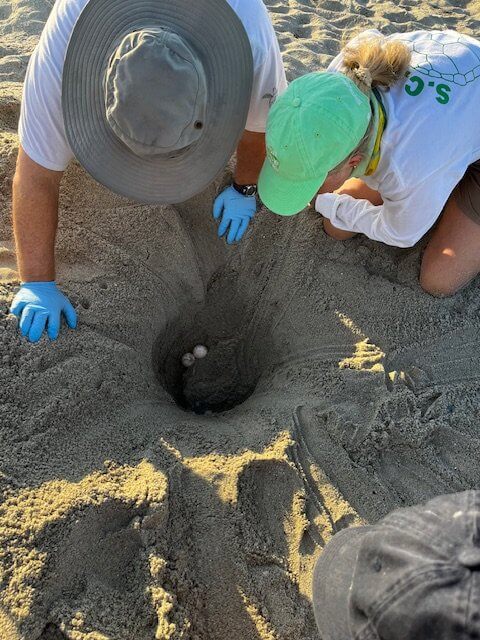
Since the turtles hatching at the top of the nest are females, Scott explained, they are concerned that hotter sand and shorter intervals will result in more females and fewer males, which could throw the numbers out of sync in the long term. This could affect the numbers of nests in the future, he said.
Schneider said she’s proud to be a part of SCUTE, which has helped turtles keep their numbers steady over the past few years.
“I enjoy protecting this very special species of turtles, the loggerhead,” she said. “It’s all about saving turtles, saving the species.”
Schneider is supported by her co-coordinator Dianna Eastman and about 50 local resident volunteers. Under a permit from the SCDNR, SCUTE volunteers serve as stewards to protect the turtles’ nesting habitat and as educators to those who show an interest in learning more about our turtles and how to help them.
Ask a volunteer
Schneider said SCUTE volunteers wear distinctive white T-shirts, and the public is invited to ask them any questions about sea turtle nesting.
“When you see a person on the beach with a SCUTE T-shirt, they are doing their jobs to protect turtle nests,” she said. “Ask them anything and they will tell you what they are doing and why they are doing it.”
When Schneider started with SCUTE, she said it was a good year to have 10 nests on Pawleys Island. She said in recent years, volunteers have seen up to 35 nests.
“These people are dedicated and have been doing this for a long time,” Schneider said. “Some of the people who walk Pawleys Island beach have been walking for 15 years or more.”
“So,” she continued, “what we are doing is certainly helping the population.”
SCUTE was formed in 1990 by Chris Marlow and Jeff McClary, who is now deceased, in response to the need for better protection of sea turtles’ nests on Pawleys Island. Since its beginning at Pawleys, SCUTE has initiated volunteer programs at 13 different beaches in Georgetown and Horry counties.
From May until the last nest hatches, volunteers monitor the beach at dawn each day for signs of turtle activity; a simple crawl onto the beach, the laying of a new nest, or the evidence of an overnight nest hatch.
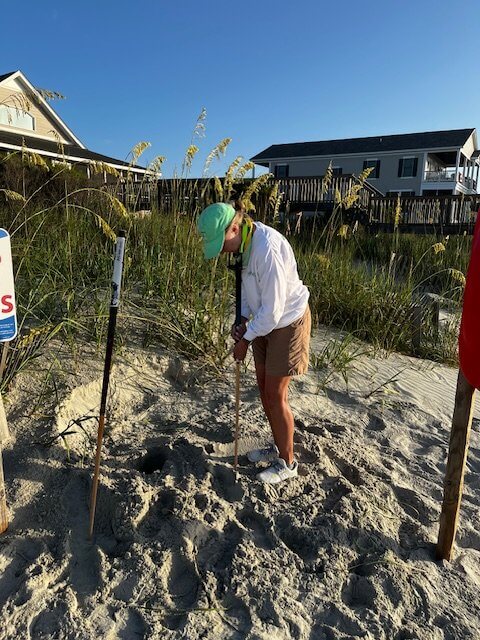
(Photo by ©maryschneider@sc.rr.com)
About sea turtles
Scott has served as head of SCUTE for the last three years and has been a member of the organization since 2011. He was a beach coordinator from 2019 to 2022. He said protecting loggerhead sea turtles is very important.
“Momma turtles look for dark, quiet locations to lay their eggs,” Scott said. “We encourage the public to turn off all beachfront lights and fill in large holes on the beach from May-October to foster a safe environment for nesting.”
There are seven species of sea turtles worldwide: loggerhead, leatherback, green, Kemp’s Ridley, flatback, hawksbill, and olive Ridley. Virtually all turtles that lay nests on Pawleys Island are loggerheads – a species over 150 million years old. Adult loggerheads are usually three feet by four feet in size and weigh about 300 pounds.
In recent years, loggerheads have made a recovery despite still being classed as endangered by the U.S. Department of the Interior. Nesting on Pawleys Island has increased from an average of eight nests a year from 1996 to 2001 to an average of 20-plus nests in the years 2010 – 2022. There was a record number of 35 nests on Pawleys Island in 2021 with 30 more in 2022. Loggerhead nests incubate for an average of 60 days with hatching almost always occurring in the coolest/darkest hours of the night.
Nest inventories
Three days after a hatching is reported by a SCUTE volunteer, the nest is inventoried and its varied contents (hatched shells, live hatchlings, un-hatched shells, dead hatchlings) are reported to the SCDNR. Hatchlings that are alive in the nest are then guided as they crawl to the ocean.
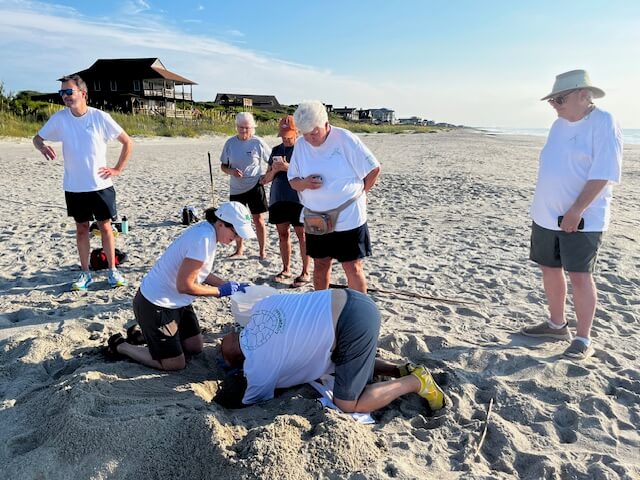
(Photo by ©maryschneider@sc.rr.com)
These inventories, which are posted at Pawleys Island Town Hall and the SCUTE Facebook page, are excellent opportunities for the public, particularly children, to learn about sea turtles and their protection.
“We welcome people to come experience these inventories,” Schneider said. “We love to focus on children because they are the next generation who are learning to take care of the earth.”
By Clayton Stairs / tourism manager for the Georgetown County Chamber of Commerce